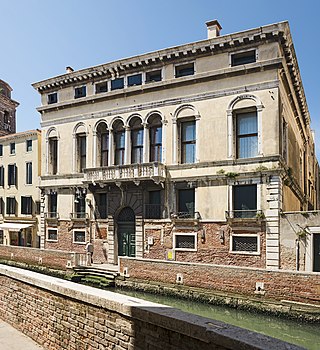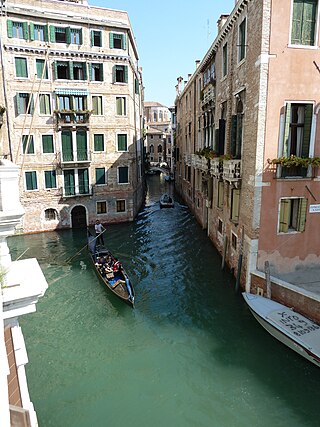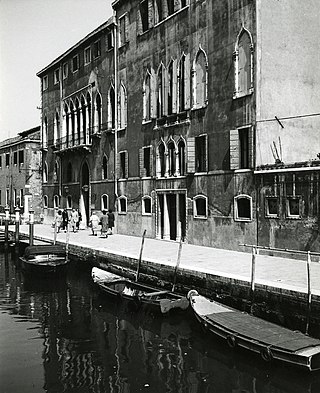
The Palazzo Grandiben Negri is a small brick palace located facing the Rio of Ca' di Dio, adjacent to the larger Palazzo Erizzo, and diagonally across the rear of the church of San Martino in the sestiere of Castello in Venice, Italy.

The Palazzo Grandiben Negri is a small brick palace located facing the Rio of Ca' di Dio, adjacent to the larger Palazzo Erizzo, and diagonally across the rear of the church of San Martino in the sestiere of Castello in Venice, Italy.
The palace was commissioned by Nicolò Grandiben of citizen ( it:Cittadini (Venezia) ) Grandiben family. A son of a 15th-century merchant, Melchiorre Grandiben, Nicolò, was ducal secretary. In 1478 he traveled to Brescia, to request that Lorenzo Zane, Patriarch of Antioch and Bishop of Brescia, who had revealed political secrets to the Pope, appear before the council and explain himself.
Nicolò Grandiben, in his will of August 8, 1490, left to his son Girolamo (also ducal secretary), the house and contents, except for part of the well with columns and marble table, were endowed for the church of San Martino for construction of a baptistery in memory of the family. This baptistery was once found in a chapel of the former church of San Daniele in Venice (destroyed 1839). [1] [2] In 1630, Diana Grandiben, daughter of Girolamo Gradinben, left the palace to her sister, Agnesina married to Marcantonio Negri. The Negri family owned the palace into at least the late 18th-century, since Francesco Negri, a prominent writer (1769-1827) was born here. It is now houses a rental property. [3]

The Grand Canal is the largest channel in Venice, Italy, forming one of the major water-traffic corridors in the city.

The Palazzo Barbarigo Minotto is a 15th-century palace on the Grand Canal in Venice, northern Italy, next to the much larger Palazzo Corner. Built in the Venetian Gothic style, it was originally two palaces, Palazzo Barbarigo and Palazzo Minotto, later joined together. The Barbarigo palace was owned by the Barbarigo family for several centuries and was the birthplace of Gregorio Barbarigo, who once refused the Papal Crown. It was later owned by the Minotto and Martinengo families.

Ca' Farsetti is a palace in Venice, Italy. It is located in the sestiere (district) of San Marco, and faces the Grand Canal, not far from the Ponte di Rialto. The neighboring building is Palazzo Cavalli.

The Museo di Palazzo Mocenigo is a palazzo near the Church of San Stae, south of the Grand Canal in the sestiere of Santa Croce in Venice, Italy. It is now a museum of fabrics and costumes, run by the Fondazione Musei Civici di Venezia.

Ca Bembo is a grade-listed sixteenth-century palazzo in the parish of San Trovaso in the sestiere of Dorsoduro in Venice, Italy, noteworthy for a particularly large garden. It has, despite its name, no clear connection with the Bembo family, but a particularly strong association with one of the most prominent branches of the aristocratic Venetian family of the Barbarigo.

The Palazzo or Ca' Cappello Layard is a palace situated in the sestiere of San Polo of Venice, Italy, overlooking the Grand Canal at the confluence between this and the smaller Rio di San Polo and Rio delle Erbe. On the Grand canal, it is located between Palazzo Barbarigo della Terrazza and Palazzo Grimani Marcello. It is particularly noteworthy for having been the residence of Austen Henry Layard, discoverer of Nineveh.

The Palazzo Michiel Dalle Colonne is a Baroque style palace located on the northern bank of the Grand Canal in the sestiere of Cannaregio in Venice, Italy. It is one building south of the junction of Rio del Santissimi Apostoli with Grand Canal, next to the Palazzo Michiel del Brusà and across the Canal from the Rialto Mercato and the Campo della Pescaria. The palace is also referred to as Palazzo Michiel Dalle Colonne a Santa Sofia.

The Palazzo Erizzo, also known as the Palazzo Erizzo a San Martino, is a palace located in the sestiere of Castello, adjacent to the south with the Palazzo Grandiben Negri, and across a Rio from the church of San Martino in Venice, Italy. A second Palazzo Erizzo alla Maddalena is located on the Grand Canal of Venice.

The Palazzo Muti Baglioni is a Baroque architecture palace located near San Cassiano in the Sestiere San Polo of Venice, Italy.

The Palazzo Manfrin Venier, once known as the Palazzo Priuli a Cannaregio or Palazzo Priuli Manfrin, is a Baroque-style palace located facing the Cannaregio Canal in the sestiere of Cannaregio of Venice, Italy. It stands to the left of the Palazzo Savorgnan.

The Palazzo Giustinian Lolin is a Baroque style palace located on the Grand Canal of Venice, Italy. The present facade was designed circa 1630 by Baldassare Longhena. It is used as an exhibition venue for the Venice Biennale.
Palazzo di Spagna a San Geremia, also known as Palazzo Frigerio is a palace located on the street Lista di Spagna street #168, once a canal but undergoing landfill in 1844, about midway down the street between the train station and the piazza of the church of San Geremia in the sestiere of Cannaregio, in Venice, Italy. In past centuries, this area of Venice became known for housing foreign embassies, which the secret-obsessed Republic of Venice wished to keep distant from its government buildings.

The Palazzo Priuli Stazio is a Baroque architecture palace located near San Giacomo dell'Orio in the sestiere of Santa Croce in Venice, Italy.

The Palazzo Donà-Ottobon is a palace located at Calle della Madonna on the Fondamenta di San Severo, corner with Calle Larga San Lorenzo, in the Sestiere of Castello in Venice, Italy. The remains of this Venetian Gothic palace are a small corner facade, alongside a canal, with two and a half walled-up gothic arcades in the piano nobile. The portal has an equally awkward marble relief of the Virgin with St Francis, St Claire de Montefalco, and a donor of reduced size. Earlier authors do not mention this portal.

The Palazzo Girardi Zecchini or Benzi Zecchini all Madonna dell'Orto is a 15th-century palace located near the church of Madonna dell'Orto in the sestiere of Cannaregio of Venice, Italy.

The Palazzo Benedetti a Santa Sofia is a 14th-century Venetian-Gothic style palace with a characteristic and rare sottoportego or portico at the canal side, located near Santa Sofia in the sestiere of Cannaregio. Across the bridge from the palace is the Palazzo Priuli Stazio. This palace also called the Palazzo di Sottoportico della Guerra.

The Palazzo Genovese is a Gothic Revival-style palace located a few meters west of the Church of the Salute along the Grand Canal, the posterior facade abuts the church of San Gregorio in the Sestieri of Dorsoduro, Venice, Italy.

The Palazzo Boldù a San Felice is a palace located on the Canal Grande of Venice, between the Palazzetto Da Lezze and Palazzo Contarini Pisani in the Sestiere of Cannaregio, Venice, Italy.

The Palazzo Bernardo a San Polo, also known as the Giustinian Bernardo is a Gothic-style palace located between Palazzo Querini Dubois and across the Rio del la Madoneta, Casa Sicher, on the Grand Canal in the sestiere of San Polo of Venice, Italy.

The Zulian family was an old Venetian noble family. The place from whence the Zulian came to Venice is unclear; however, the family is considered one of the first that moved to Venice, and thus one of the oldest Venetian and Italian noble families. The family produced tribunes, and in the early 8th century gained dukedom, as a family member rose to the position of Maestro dei cavalieri. The family produced several prominent Venetian figures, including statesmen, generals, patrons and magnates.